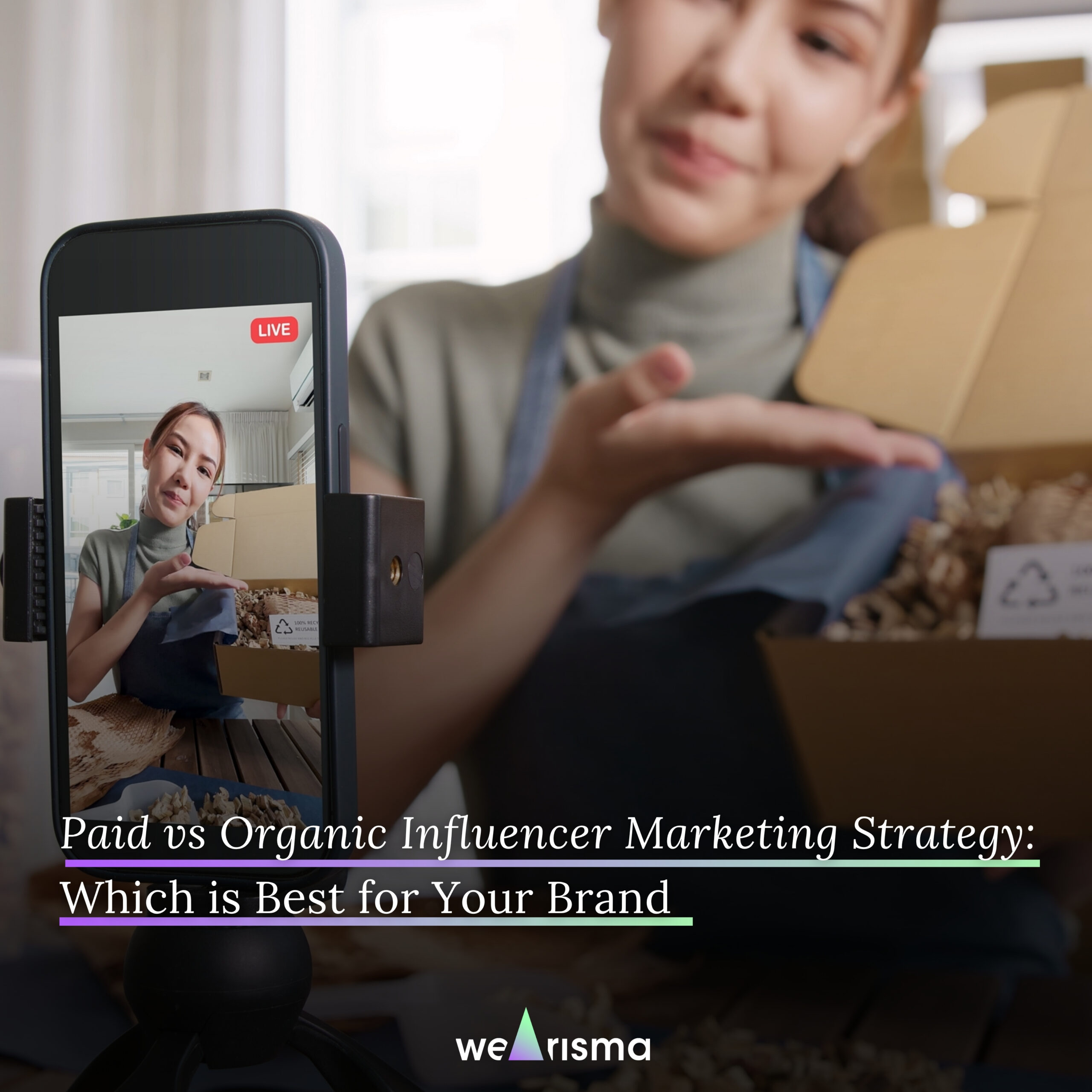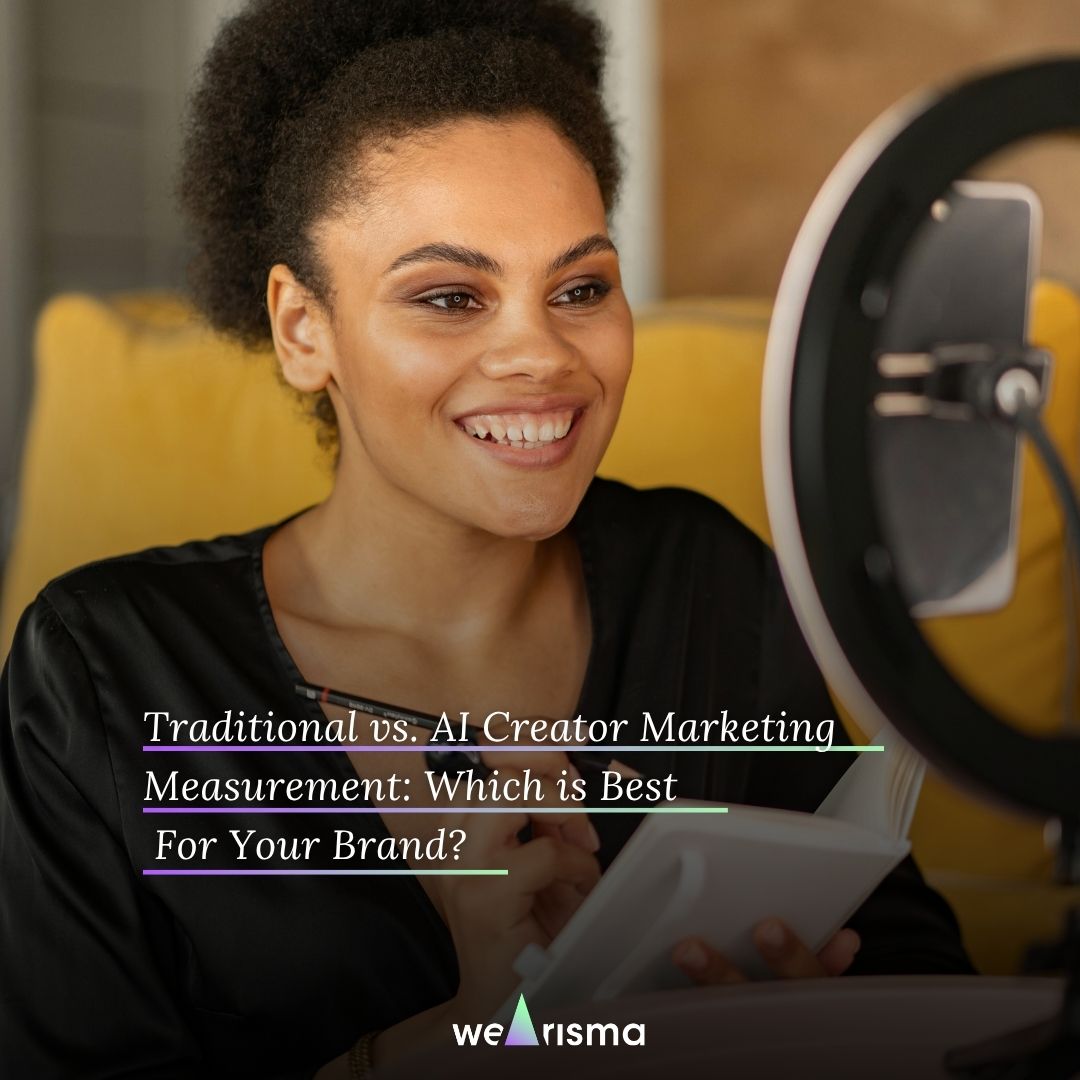🎉 WeArisma joins forces with NielsenIQ (NIQ) to, for the first time ever, measure the impact of Creator Marketing on sales.
Discover the dynamics of paid and organic influencer marketing strategies to decide which route is best for your brand.

Published On: May 30, 2025
Paid vs Organic influencer marketing strategy: which is best for your brand? Find out right here with our insider guide.
Influencer marketing is a powerful tool for brands looking to build trust, expand their reach, and make a mark in their industry. While once seen as an optional bolt-on, influencer marketing is now a sophisticated commercial strategy.
It’s a discipline that will place your brand in front of your target audience at the right time in their journey. In fact, we’ve discovered that influential voices often deliver a significantly greater impact than brand-owned content.
While developing meaningful influencer partnerships will level up your brand reach in a saturated space, deciding whether to go the paid or organic route isn’t easy. Here, we’ll look at the key differences between paid and organic strategies to help you make the best choice for your brand.
So, what is the difference between paid and organic influencer marketing strategies? Let’s explore.
Paid influencer marketing strategies revolve around compensating influencers to endorse your brand or its products. These types of collaborations are disclosed to the public, with creators marking posts as paid partnerships and (or) branded or sponsored content. Also, if gifting comes with obligations, it should also be disclosed as ‘paid for’ to ensure transparency.
Typically, paid influencer marketing content comes in the form of:
According to The Influencer Marketing Academy, 47.4% of brands spend $10,000 or less on their influencer marketing campaigns, with 14.5% spending more than $500,000. While paid partnerships can be effective, leaning solely on sponsored collaborations may limit your influencer marketing strategy.
As such, you should explore organic influencer marketing strategies founded on building long term partnerships to expand the scope of your campaigns, content, and creator-based initiatives.
Organic influencer marketing strategies revolve around nurturing meaningful relationships based on shared tastes and values. Organic partnerships are free from obligation, which means the influencer can choose not to participate in a particular promotion, promote a product or share a specific piece of messaging.
Organic influencer marketing content often comes in the form of:
Organic influencer discovery and outreach takes time and perseverance, but it’s usually far more authentic than ‘pay to play’ content. When an influencer genuinely respects your values and what you do (or offer), they’ll become brand advocates.
Well-positioned organic partnerships will ensure your influencers’ messaging speaks directly to your audience, and you’ll likely earn more engagement from your campaign activities. You’ll become creative partners. Why? It’s because organic influencer relationships are founded on shared goals and aligned values, often resulting in the most impactful outcomes.
Lots of forward-thinking brands across industries adopt a hybrid approach to their influencer marketing strategies. If you choose to balance paid endorsements with organic influencer partnerships, you should set a clear budget and performance benchmarks. Doing so will ensure you don’t overinvest in paid influencer marketing and drive a healthy ROI from your activities.
If you do the ‘hybrid’ route, we recommend focusing on building organic influencer partnerships and leveraging paid opportunities to complement them or further highlight specific products and promotions. That way, you’ll form the foundations of a balanced strategy that meets or exceeds your creator marketing goals consistently.
We live in an attention-poor age. Consumers can gorge on content across every channel or touchpoint imaginable – so why is yours worth their time? That’s a question that every brand manager or marketing decision-maker often asks themselves. We’re sure you’re no exception.
Brand-aligned organic influencer content is one of the most impactful branches of marketing right now. Today’s consumers crave authenticity, and real organic moments are the best way to stand out in their feeds.
Carefully curated and nurtured influencer partnerships can elevate brand reputations and earn genuine engagement, which often converts into long-term advocacy.
Our State of Influence report shows that influencer marketing is making significant waves across industries. In the personal care sector, for instance:
Based on our insights, what’s clear is that an industry-wide rise in influencer marketing largely drives this growth. Interestingly, we’ve seen similar patterns and trends across other key industries, including sport & athleisure, beauty, luxury, and fashion.
For authenticity, attention, and growth, here are three essential elements of any impactful organic influencer marketing strategy.
We’ve found that identifying the right influencers for your brand and campaign is essential. Working with nano influencers or micro influencers in your niche will likely make the biggest impact as you can tap into slightly smaller yet highly-engaged audiences. Reaching focused audiences with interests or motivations that align with what you have to offer will drive the healthiest ROI – so choose your partnerships wisely.
Rather than aiming for virality alone, your influencer marketing content should speak directly to your audience and their motivations. Leveraging the right influencers to share or amplify messages that offer actual value to your target consumers is the best way to build trust and convert. Often, ‘going viral’ is the side effect of well-placed, thoughtfully curated messaging.
While the likes EMV, impressions, and brand mentions all have their place in influencer campaign analysis, without real context, these are often little more than vanity metrics. Without the right tools, it’s hard to accurately track the impact of organic influencer campaigns, as so much related content gets lost in the mix.
WeArisma’s AI organic measurement tool can help you reach beyond vanity metrics to measure your earned media impact and identify the influential sources discussing your brand with razor-sharp efficiency.
Investing in meaningful organic influencer marketing strategies and using paid partnerships to complement your efforts is the best way to ensure consistent success.
Shifting consumer preferences are changing conceptions of what good looks like. These ever-evolving attitudes call for new ways of thinking about earned media success – organic influencer marketing is the way forward. The time to act is now.
Put theory into action with our insider guide on creating an influencer strategy that drives results.
Access timely cultural trends, strategic creator guidance, and industry best practices.
Discover the most groundbreaking entertainment marketing insights from our eye-opening panel discussion at ‘The State of Influence 2025 and future-proof your brand for tomorrow’s creator economy.
Fashion and Sport Brands Global Analysis.
Wimbledon’s evolution into a cultural engine allows brands to move beyond visibility, fostering deeper resonance through tradition, lifestyle, and aspirational storytelling.
In an experience-driven economy, where influence is shaped by shared moments and storytelling, Wimbledon provides a rare opportunity to reach global audiences in a context that extends well beyond sport.


Join our community and get cultural insights, creator strategy guides, and real-world best practices.